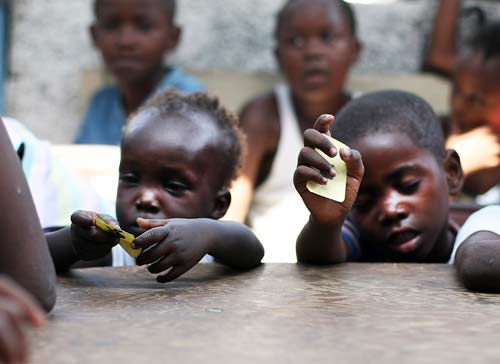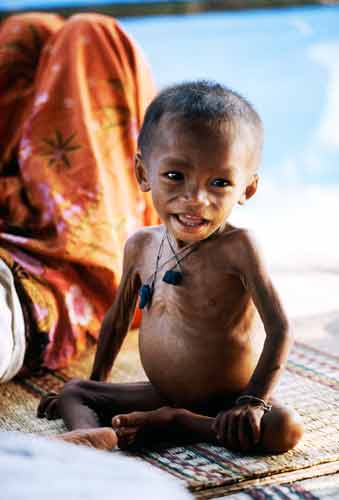Problems linked to malnutrition
Overeating and malnutrition
In many countries food security has existed for decades. Populations have never had any difficulty with regard to the availability or accessibility of the foods they require.
Moreover many people, particularly children, associate food with pleasure, often forgetting daily nutritive requirements, so that fast food, sugared sodas, and foods rich in fat and carbohydrates become the preferred foods of adolescents and younger children. Overeating and dietary excess have become more and more common, and constitute a real threat to the health of children and adults.
The primary consequence of this excess is obesity. Massive excess of weight considerably increases the risk of developing certain illnesses: high blood pressure, high cholesterol levels, growth problems brought about by excess weight, risk of heart attack, cardiovascular illness…
Overeating and malnutrition linked to excessive eating do not only concern developed countries. A significant number of developing countries today face the problems associated with overeating, as well as undernourishment.
Undernourishment and malnutrition

An adequate and balanced diet allows us to avoid undernourishment and malnutrition. Consuming under 2100 calories a day, one is considered to be under-nourished and suffering from hunger. Under-nourished children often also suffer from malnutrition.
A child who does not receive essential nutritive elements can suffer from malnutrition and will be exposed to serious health problems which can hamper their healthy development.
2 types of malnutrition: :
• Chronic malnutrition : characterised by delayed growth in the child, who will not be a healthy height for their age.
• Acute malnutrition : characterised by insufficient weight in relation to the child’s height (emaciation). Acute malnutrution can be moderate or severe according to the child’s weight.
Under-nourishment and malnutrition have serious consequences for the health of the child, particularly in younger children.
Three major micronutrient deficiencies:
Iron deficiencies can cause growth problems and problems with intellectual development, as well as a weakened immune system and greater exposure to those illnesses present in disadvantaged areas: pneumonia, diarrhoea, malaria, measles and Aids.
Iron is contained in foods such as red meat, some fish, dried fruits, some cereals and dark green vegetables.
Iodine deficiencies can lead to irreversible brain lesions, which can lead to mental retardation. Iodine deficiencies can also cause goitre (swelling of the thyroid), and some other thyroid problems.
Iodine is found mostly in salt, algae, fish and seafood, but also in some vegetables such as green beans.
Vitamin A deficiencies can cause blindness or death. Vitamin A (retinol) is found in animal foods such as liver, oily fish, or indeed in cod liver oil. Vitamin A (carotenoid) is also present in plant-based foods such as carrots, spinach, broccoli, oranges and mango. Micronutrient deficiencies, over long periods, are often fatal in children under 5.

Other deficiencies (vitamin B1, vitamin B2), can slow down children’s development. Nutritional insufficiencies often lead to concentration problems which lead in turn to high numbers of children leaving school and high levels of illiteracy.
Malnutrition and HIV/ AIDS
People in developing countries, particularly children, are more at risk of being exposed to the AIDS virus and HIV. These risks are higher due to both social and medical reasons: poverty forces people, men, women, boys and girls, into prostitution in order to provide for themselves. Generally these people do not have enough information about the risks and the consequences of unprotected sexual relations. Moreover, many women affected by the virus give birth to children who are also HIV positive and thus have less chance of survival.

Also, children suffering from malnutrition have a weakened immune system and are more vulnerable to infections, in particular to HIV/AIDS. HIV itself, as its name (Human Immunodeficiency Virus) indicates, also weakens the immune system, and impedes the person’s assimilation of nutrients contained in food. The HIV/AIDS virus also has the effect of increasing the body’s at-rest energy requirements. For this reason, sufferers must consume more calories to make up for the body’s requirements. However, people suffering from HIV/AIDS in developing countries are already suffering from malnutrition, and therefore do not have access to adequate food to meet these growing deficiencies.
Malnutrition combined with HIV/AIDS causes serious deterioration in children’s health. Completely weakened and drained, the children generally succumb to those illnesses linked to nutritional deficiencies, and any other infections, even the most benign.

